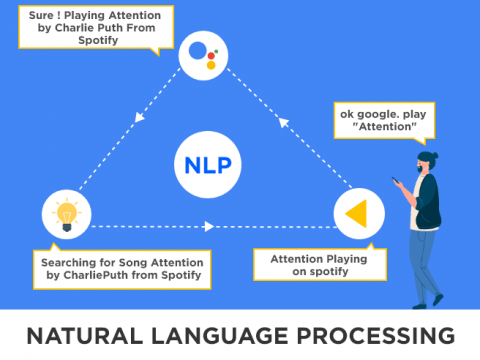NLP (Natural Language Processing) Tutorial: Get started with NLP
Introduction
Nowadays, language is getting a lot of importance due to the recent boom of the so-called chatbots or conversational agents in several industries. But, as it happens with other fields of human knowledge, the study of natural language has a long past and these agents are not the first important application. Having a deep understanding of language is very important since we use it everyday in different scenarios and with different behaviors.
This series of tutorials have the purpose of serving as an introduction to the amazing field of study that constitutes Natural Language Processing.
What is Natural Language Processing?
NLP stands for Natural Language Processing, which is defined as the application of computational techniques to the analysis and synthesis of natural language and speech. In other words: the use of different techniques from computer science (algorithms) to understand and manipulate human language and speech.
NLP helps developers to organize and structure knowledge to perform tasks like translation, summarization, named entity recognition, relationship extraction, speech recognition, topic segmentation, etc.
NLP is a way of computers to analyze, understand and derive meaning from a human languages such as English, Spanish, Hindi, etc.
In this NLP tutorial, you will learn:
- What is Natural Language Processing?
- Components of NLP
- NLP Implementations
- Libraries for NLP
- NLP vs. Computational Linguistics
- Advantages of NLP
- Disadvantages of NLP
- Conclusion
Components of NLP
Two main Components of NLP-
Natural Language Understanding (NLU)Natural Language Understanding revolves around machine reading comprehension. This is an AI-hard problem. An NLU system needs the following components-
- Lexicon, Parser, and Grammar rules
- Semantic theory- to guide comprehension
Natural Language Generation (NLG)
NLG is concerned with generating natural language. It uses a machine representation system like a knowledge base or a logical form. You can think of it as a translator between data and natural language representation; this is the opposite or NLU. This involves three tasks-
- Text Planning- To extract relevant content from the knowledge base.
- Sentence Planning- To choose appropriate words, form meaningful phrases, and set sentence tone.
- Text Realization- To map the sentence plan into sentence structure.
NLP Implementations
These are some successful implementations of natural language processing ( NLP):
- Search engines like Google, Yahoo, etc. Google’s search engine understands that you are a tech guy, so it shows you results related to that.
- Social website feeds like your Facebook news feed. The news feed algorithm understands your interests using natural language processing and shows you related ads and posts more likely than other posts.
- Speech engines like Apple Siri.
- Spam filters like Google spam filters. It’s not just about your usual spam filtering; now, spam filters understand what’s inside the email content and see if it’s spam or not.
Libraries for NLP
There are many open source Natural Language Processing ( NLP) libraries. These are some of them:
- Natural language toolkit (NLTK)
- Apache OpenNLP
- Stanford NLP suite
- Gate NLP library
Natural language toolkit (NLTK) is the most popular library for natural language processing ( NLP). It was written in Python and has a big community behind it.
NLTK also is very easy to learn, actually, it’s the easiest natural language processing ( NLP) library that you’ll use.
NLP vs. Computational Linguistics
There’s an area which is closely related to NLP and sometimes confused with it, that is Computational Linguistics. The difference is the following:
- Computational Linguistics is a more theoretical field that develops computational methods to answer the scientific questions from the point of view of linguists.
- Natural Language Processing is dedicated to give solutions to engineering problems related to natural language, focusing on the people
Both fields make use of Computer Science, Linguistics, and Machine Learning.
Advantages of NLP
- Users can ask questions about any subject and get a direct response within seconds.
- NLP system provides answers to the questions in natural language
- NLP system offers exact answers to the questions, no unnecessary or unwanted information
- The accuracy of the answers increases with the amount of relevant information provided in the question
- NLP process helps computers communicate with humans in their language and scales other language-related tasks
- Allows you to perform more language-based data compares to a human being without fatigue and in an unbiased and consistent way
- Structuring a highly unstructured data source
Disadvantages of NLP
- Complex Query Language- the system may not be able to provide the correct answer it the question that is poorly worded or ambiguous
- The system is built for a single and specific task only; it is unable to adapt to new domains and problems because of limited functions.
- NLP system doesn’t have a user interface which lacks features that allow users to further interact with the system
Conclusion
In this Natural language Processing Tutorial, we discussed NLP Definition, AI natural language processing, and example of NLP. Moreover, we talked about its fundamentals, components, benefits, libraries, terminologies, tasks, and applications. Still, if any doubt regarding NLP Tutorial, ask in the comment tab.
For reference-
Mildaintrainings: Our trainers have 12+ years of industry practical experience and we also provide Practical training with the live project so that you could understand each and everything better, it will help you in your job. At Mildaintraining we will provide you six months Technical support as well.



